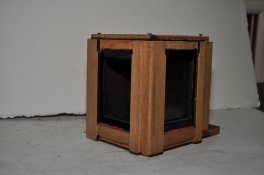US Patent - Des. 115,165 - Curtis Color Camera
Not very exciting though. Haven't found the goods yet.
edit: Adding some as I come across them; haven't read any yet though.
USP 1,895,555 - Emil Reckmeier 1933 - (Dead Link Removed)
USP 1,951,896 - Bermpohl 1934
The 1951896 is the one I just found in my archives. There are pics of the mirror arrangements, but not specific angles and dangles. I had planned to get a protractor to get close, then calculate the needed angles necessary. But time never presented itself.
The advantage of these over a straight 90 degree splitter is the focal path is shorter, so you can get wider lenses, and the body is smaller.
As far as my earlier statement that one of the three would have the image reversed, that's of no real consequence, and was an attribute of many commercial systems of the day. Printers simply dealt with it.
I had the idea that the first mirror needs to have slight registration marks in opposing corners so you can easily line things up later. Frame generously.
My original thinking was to learn to process the three images in the K-14 chemicals, without the requirements of doing it in the real K-14 process, then aligning the three sheets to make a transparency. Hence my suggestion for K-15 name.
Of course, one could always simply develop for color separations to print.
Last edited by a moderator:





